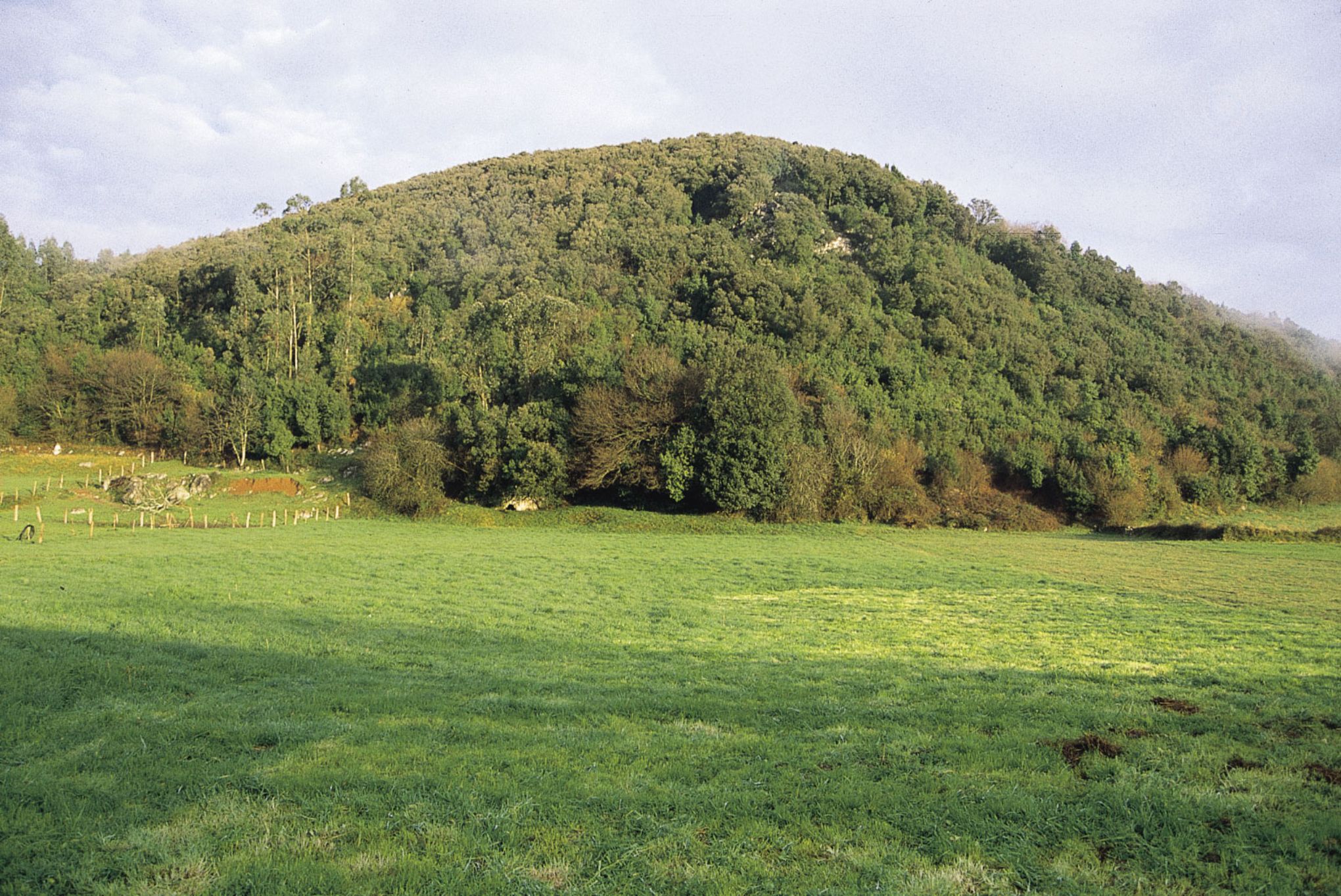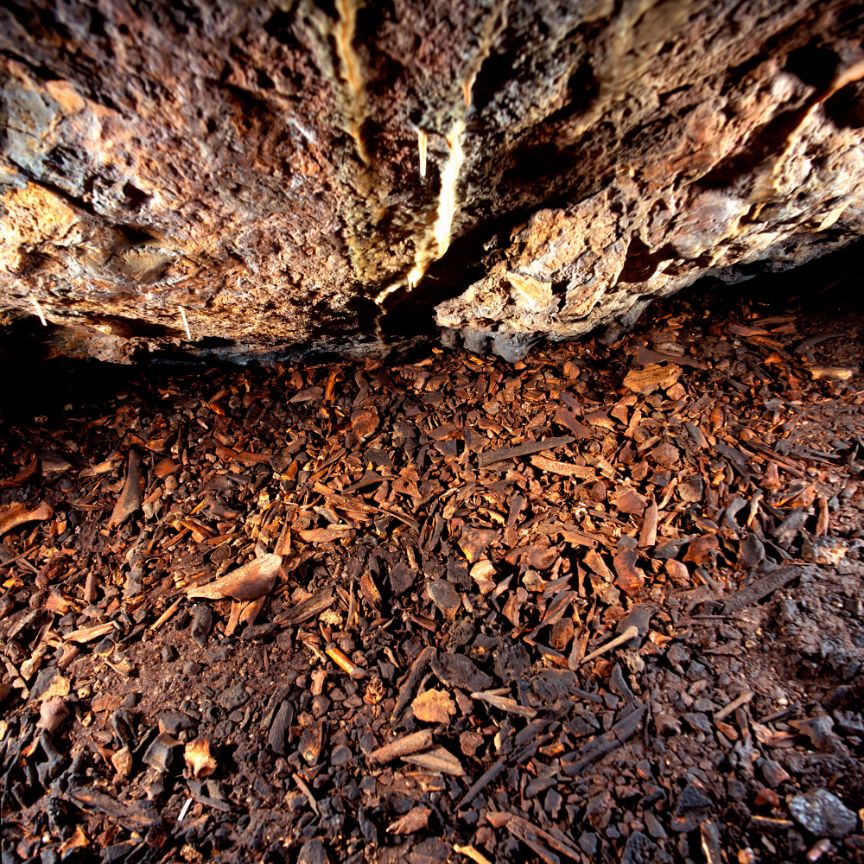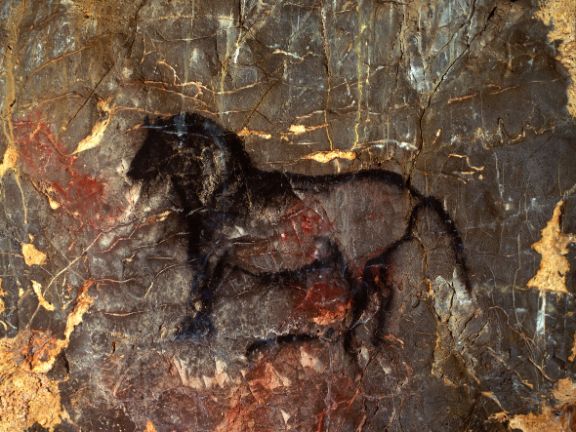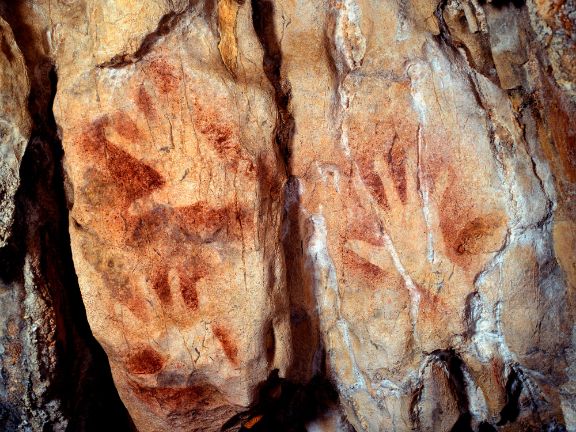La Garma Cave – Lower Gallery

Identification of the Property
SubirNozaleda, Omoño, Ribamontán al Monte, Autonomous Community of Cantabria
Access
On the E-70, take the exit towards Villaverde de Pontones, on the CA146. Continue on the local road towards Meruelo, go through the Pontones, and stop in the village of Omoño. A footpath leads to the cave entrance.
Geographical coordinates
UTM 30T 446230E / 4809085N Z: 55
Descripción
SubirTopographic description
The Lower Gallery is the third level in the cave system of La Garma, which has formed in the limestone hill of the same name. The access is through La Garma Cave A. The first passage ends at a 8m drop into the Intermediate Gallery, and a further 14m shaft descends to the Lower Gallery, approximately half-way along the length of this passage. If we were to start at the original entrance, which was blocked by roof collapse at the end of the Pleistocene, the cave can be described as a wide, almost straight passage running from the SSW to the NNE, 70m long and averaging 7m in width. In this part of the cave, hundreds of square metres of the floor are covered with the remains of food, and lithic and bone working, as well as objects of adornment and other pieces of portable art. It goes into a series of small chambers that reach a transversal section, ending at another chamber, 7m in diameter. A long passage leads off to the W, interrupted in places by boulder collapses, until it reaches the top of a shaft, about 25m deep. The stream that formed the cave flows at the bottom of this last drop, and later rises at the foot of the hill, at a spring called “Fuente en Cueva”. The cave also has a number of smaller side-passages, leading off both sides of the main passage at different heights and in different directions. The total length of the cave is 300m. The height of the ceiling varies, and occasionally is over 20m high, where high level fossil passages have collapsed.
 Pulse para ampliar
Pulse para ampliar
Date of Discovery
The discovery of the Lower Gallery, its archaeological deposits and prehistoric art, took place on 2nd November 1995, while archaeological excavations were being carried out at the entrance of La Garma A (the only access to the cave system) under the direction of P. Arias and R. Ontañón. Members of the research team, M.L. Serna and J.M. Ayllón, assisted by J. Herrera, made the discovery when they descended the shaft from the Intermediate Gallery.
Archaeological research
Since 1996, a full programme of archaeological research is being undertaken at the site, as part of the project “Integral Study of La Garma Archaeological Complex”, funded through an agreement between the Consejería de Cultura, Turismo y Deporte of the Government of Cantabria and the University of Cantabria, under the direction of P. Arias and R. Ontañón. The objectives of the project are the research and conservation of a truly outstanding archaeological site. In the Lower Gallery, the cave art is associated with occupation floors of middle Magdalenian chronology, preserved intact together with a number of stone circles. Therefore, this site, which is still being documented, has an enormous potential for the study of Palaeolithic art within its original context. This study is currently being carried out by C. González Sainz and A. Moure Romanillo. Also in the Lower Gallery, five skeletons and numerous remains of torches and hearths have been found and dated to the Medieval period.
 Pulse para ampliar
Pulse para ampliar
 Pulse para ampliar
Pulse para ampliar
Artistic contents: paintings and engravings
To date, over 500 Palaeolithic paintings and engravings have been found in the Lower Gallery: some 100 animal figures (horses, hinds, stags, bison, aurochs, ibex, megaceros, carnivores and other quadrupeds), 40 stencilled hands, more than 100 signs, dots and paired marks, and some 250 lines and stains of colour.
This art belongs to different phases of production, from the beginnings of Palaeolithic art until the middle Magdalenian. The figures are distributed throughout the cave, although they are concentrated in some particular areas. They are most abundant in the area nearest to the original entrance (called Zone I) and become scarcer in the interior sectors.
This distribution has a chronological component, as the Magdalenian art is mostly at the start of the cave, while the more archaic depictions are nearer the end. An important aspect of the art in the Lower Gallery is that it is directly associated with the “activity areas”, especially in Zone I, but also in Zone III, 90m from the original entrance and even in Zone IV, 130m from the entrance. This circumstance makes it possible to analyse the context of Palaeolithic art: the elements of the cave and the archaeological artefacts that it is associated with.
Bibliography
SubirARIAS CABAL, P., GONZÁLEZ SAINZ, C., MOURE ROMANILLO, A., ONTAÑÓN PEREDO, R. 1997. El proyecto “Estudio integral del complejo arqueológico de La Garma (Omoño, Cantabria)”. Primeros resultados. En BALBÍN BEHRMANN, R. de y BUENO RAMÍREZ, P. (eds.): Actas del II Congreso de Arqueología Peninsular. Tomo I. Paleolítico y Epipaleolítico: 147-162. Zamora: Fundación Rei Afonso Henriques.
ARIAS CABAL, P., GONZÁLEZ SAINZ, C., MOURE ROMANILLO, A., ONTAÑÓN PEREDO, R. 2000. Estudio integral del Complejo Arqueológico de La Garma (Omoño, Ribamontán al Monte). En Ontañón Peredo, R.(coord.): Actuaciones Arqueológicas en Cantabria 1984-1999: 271-277. Santander: Consejería de Cultura y Deporte de Cantabria.
ARIAS CABAL, P., GONZÁLEZ SAINZ, C., MOURE ROMANILLO, A., ONTAÑÓN PEREDO, R. 2000. La zona arqueológica de La Garma (Cantabria): Investigación, conservación y uso social. Trabajos de Prehistoria Vol. 57, nº 2: 14-26.
ARIAS CABAL, P., GONZÁLEZ SAINZ, C., MOURE ROMANILLO, A., ONTAÑÓN PEREDO, R. 2003. Unterirdischer Raum, Wandkunst und paläolithische Strukturen. Einige Beispiele der Höhle La Garma (Spanien). En Pastoors, A. y Weniger, G.-C. (eds.) Höhlenkunst und Raum: Archäologische und architektonische Perspektiven, pp. 29-46. (Wissenschaftliche Schriften des Neanderthal Museums, Band 3). Mettmann: Neanderthal Museum.
ARIAS, P., GONZALEZ-SAINZ, C., MOURE, A., ONTAÑON, R. 2004. La Galerie Inférieure de La Garma (Cantabria, Espagne): Recherche et conservation d’un complexe archéologique exceptionnel. Les Nouvelles de l’Archéologie 95: 41-45.
GONZÁLEZ SAINZ, C. 2003. El conjunto parietal de la Galería Inferior de La Garma (Omoño, Cantabria). Avance a su organización interna. En Balbín Behrmann, R. de y Bueno Ramírez, P. (eds.): El arte prehistórico desde los inicios del siglo XXI (Primer symposium internacional de arte prehistórico de Ribadesella): 201-222. Ribadesella: Asociación Cultural Amigos de Ribadesella.
ONTAÑÓN PEREDO, R. (coord.) 1999 (2ª ed. 2001). La Garma: Un descenso al pasado. Santander: Consejería de Cultura y Deporte del Gobierno de Cantabria.
ONTAÑÓN PEREDO, R. 2003. Sols et structures d’habitat du Paléolithique supérieur, nouvelles données depuis les Cantabres: La Galerie Inférieure de La Garma (Cantabria, Espagne). L’Anthropologie 107/3: 333-363.
ONTAÑÓN PEREDO, R. 2018. 10 Cuevas Patrimonio Mundial en Cantabria. Santander: Consejería de Educación, Cultura y Deporte - Gobierno de Cantabria / Asociación de Amigos del MUPAC.



